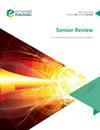具有分离弹性结构的三维光纤布拉格光栅腕力传感器
IF 1.6
4区 工程技术
Q3 INSTRUMENTS & INSTRUMENTATION
引用次数: 0
摘要
目的使用力传感器估算机械手的外力不仅需要处理传感器本身的信号噪声,还需要解决传感器本身的耦合干扰,尤其是轴向力。本文的目的是开发一种三维光纤布拉格光栅(FBG)腕力传感器,该传感器结构简单,减少了几个轴之间的耦合影响。一个 FBG 悬挂在中心圆柱体的轮廓上,其他三个 FBG 分别粘贴在上测量体和下测量体的弹性梁表面上。对结构的应变分布特性、各方向的输出特性和耦合效应进行了有限元分析(FEA)模拟。实验结果表明,传感器的最大重复性误差为 6.75%,最大非线性误差为 5.36%,最大耦合干扰为 4.73%,最小灵敏度为 1.58 pm/N。该传感器可降低多个轴之间的耦合影响,尤其是 Z 方向的耦合干扰为 0。本文章由计算机程序翻译,如有差异,请以英文原文为准。
A three-dimensional fiber Bragg grating wrist force sensor with separation elastic structure
Purpose
The use of a force sensor to estimate the external force of manipulator not only needs to deal with the signal noise of the sensor itself but also needs to solve the coupling interference of the sensor itself, especially the axial force. The purpose of this paper is to develop a three-dimensional fiber Bragg grating (FBG) wrist force sensor, which has a simple structure and reduces the coupling influence between several axes.
Design/methodology/approach
A particular separation elastic structure with four FBGs is devised for the three-axial force sensor. One FBG is suspended on the profile of central cylinder and the other three FBGs are pasted on the elastic beam surface of the over and under measuring bodies, respectively. Finite element analysis (FEA) simulation has been implemented to the strain distribution characteristics, the output characteristics of each direction and the coupling effects of the structure. Furthermore, theoretical derivation and experimental results are used to compare, which have a good consistency.
Findings
The experiment results show that the maximum repeatability error of the sensor is 6.75%, the maximum nonlinear error is 5.36%, the maximum coupling interference is 4.73% and the minimum sensitivity is 1.58 pm/N.
Originality/value
A three-dimensional force sensor based on FBG adopts a particular separation elastic structure. The sensor can reduce the coupling influence between several axes, especially the coupling interference in the z-direction is 0.
求助全文
通过发布文献求助,成功后即可免费获取论文全文。
去求助
来源期刊

Sensor Review
工程技术-仪器仪表
CiteScore
3.40
自引率
6.20%
发文量
50
审稿时长
3.7 months
期刊介绍:
Sensor Review publishes peer reviewed state-of-the-art articles and specially commissioned technology reviews. Each issue of this multidisciplinary journal includes high quality original content covering all aspects of sensors and their applications, and reflecting the most interesting and strategically important research and development activities from around the world. Because of this, readers can stay at the very forefront of high technology sensor developments.
Emphasis is placed on detailed independent regular and review articles identifying the full range of sensors currently available for specific applications, as well as highlighting those areas of technology showing great potential for the future. The journal encourages authors to consider the practical and social implications of their articles.
All articles undergo a rigorous double-blind peer review process which involves an initial assessment of suitability of an article for the journal followed by sending it to, at least two reviewers in the field if deemed suitable.
Sensor Review’s coverage includes, but is not restricted to:
Mechanical sensors – position, displacement, proximity, velocity, acceleration, vibration, force, torque, pressure, and flow sensors
Electric and magnetic sensors – resistance, inductive, capacitive, piezoelectric, eddy-current, electromagnetic, photoelectric, and thermoelectric sensors
Temperature sensors, infrared sensors, humidity sensors
Optical, electro-optical and fibre-optic sensors and systems, photonic sensors
Biosensors, wearable and implantable sensors and systems, immunosensors
Gas and chemical sensors and systems, polymer sensors
Acoustic and ultrasonic sensors
Haptic sensors and devices
Smart and intelligent sensors and systems
Nanosensors, NEMS, MEMS, and BioMEMS
Quantum sensors
Sensor systems: sensor data fusion, signals, processing and interfacing, signal conditioning.
 求助内容:
求助内容: 应助结果提醒方式:
应助结果提醒方式:


